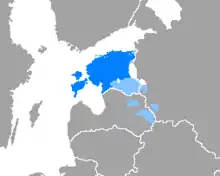Estonian language
The Estonian language (Estonian: eesti keel) is a Uralic language. It is mainly spoken in Estonia. The Estonian language is similar to Finnish and is one of the few national languages of Europe not to be an Indo-European language.
| Estonian | |
|---|---|
| eesti keel | |
| Native to | Estonia |
| Ethnicity | Estonians |
Native speakers | 1.1 million (2012)[1] |
| Latin (Estonian alphabet) Estonian Braille | |
| Official status | |
Official language in | |
| Regulated by | Institute of the Estonian Language / Eesti Keele Instituut, Emakeele Selts (semi-official) |
| Language codes | |
| ISO 639-1 | et |
| ISO 639-2 | est |
| ISO 639-3 | est – inclusive codeIndividual codes: ekk – Standard Estonian vro – Võro |
| Glottolog | esto1258 |
| Linguasphere | 41-AAA-d |
 Distribution of estonian language | |
The Estonian alphabet uses the Latin alphabet. It has many vowels, including Ö, Ä, Õ and Ü.
It has been influenced by and adopted many words from German and Swedish. The Estonian language also has different dialects.
Sample words
| Üks | One |
| Kaks | Two |
| Kolm | Three |
| Jah | Yes |
| Ei | No |
| Mina/Ma | I |
| Sina/Sa | You (in singular) |
| Tema/Ta | He/She |
| Meie/Me | We |
| Teie/Te | You (in plural) |
| Nemad/Nad | They |
| Olen/Mina olen | I am |
| Eesti | Estonia |
| Maja | House |
| Kodu | Home |
| Tee | Way |
Estonian edition of Wikipedia, the free encyclopedia
- Estonian at Ethnologue (18th ed., 2015)
Standard Estonian at Ethnologue (18th ed., 2015)
Võro at Ethnologue (18th ed., 2015)
This article is issued from Wikipedia. The text is licensed under Creative Commons - Attribution - Sharealike. Additional terms may apply for the media files.